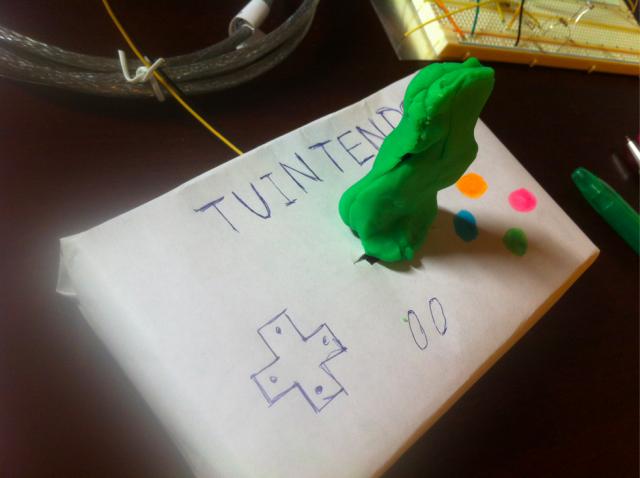Lab4 - TUINTENDO
Description
I reproduced a 90's console game with Arduino and Processing. A stogy controller with buttons and a joy stick and a simple design of game in a small screen evoke nostalgia of 90's games. At that time, although the games were simple and coarse, we enjoyed playing them a lot of time.
When you push the joy stick, the red rectangle arises. Your mission is to evade collision with reckless white balls!

Components
Arduino Uno
Force Sensing Resistor
10ohm resistor
a snack box
Code
Arduino
#include <SoftwareSerial.h>
/*
* Resistive Sensor Input
* Takes the input from a resistive sensor, e.g., FSR or photocell
* Dims the LED accordingly, and sends the value (0-255) to the serial port
*/
int photoPin = 0;
int forcePin = 1; // select the input pin for the sensor
int ledPin = 11; // select the output pin for the LED
int photoval = 0;
int forceval = 0; // variable to store the value coming from the sensor
//SoftwareSerial forceSerial(0,1);
void setup() {
Serial.begin(9600);
// forceSerial.begin(14400);
}
void loop() {
photoval = analogRead(photoPin);
// forceval = analogRead(forcePin); // read the value from the sensor, 0-1023
// analogWrite(ledPin, val/4); // analogWrite (dimming the LED) can be between 0-255
Serial.println(photoval/2); // writing the value to the PC via serial connection
// forceSerial.println(forceval/4);
delay(50); // rest a little...
}
Processing
import processing.serial.*;
// Change this to the portname your Arduino board
//String portname = "/dev/tty.usbserial-A4001nLJ"; // or "COM5"
String portname = "/dev/tty.usbmodemfa131"; // or "COM5"
Serial port;
String buf="";
int cr = 13; // ASCII return == 13
int lf = 10; // ASCII linefeed == 10
MovingCircle myCircle = new MovingCircle(50,50,10);
MovingCircle myCircle2 = new MovingCircle(150,150,20);
MovingCircle myCircle3 = new MovingCircle(250,250,30);
int force = 0;
int c = 0;
int h = 0;
void setup() {
size(400,512);
frameRate(50);
smooth();
background(40,40,40);
noStroke();
port = new Serial(this, portname, 9600);
fill (255,0,0);
h = height - 40;
rect (width / 2 - 20, h, 40, 40);
}
void draw() {
background(0);
// update the position of the circles
myCircle.update();
myCircle2.update();
myCircle3.update();
// check for collisions with the walls
myCircle.checkCollisions();
myCircle2.checkCollisions();
myCircle3.checkCollisions();
// and draw each one
myCircle.drawCircle();
myCircle2.drawCircle();
myCircle3.drawCircle();
if (c != lf && c != cr)
force = c;
if (force <= 48) {
h = h + 6;
if (h > height - 40)
h = height - 40;
}
else {
h = h - 2;
if (h < 0)
h = 0;
}
fill (255,0,0);
rect (width / 2 - 20, h, 40, 40);
}
void keyPressed() {
if(key == ' ') {
background(40,40,40); // erase screen
}
else {
int x = int(random(0,width));
int y = int(random(0,height));
drawball(x,y, 50);
}
}
// draw balls
void drawball(int x, int y, int r) {
for (int i=0; i<100; i++ ) {
fill(255-i,i,240);
ellipse(x,y,r,r);
}
}
// called whenever serial data arrives
void serialEvent(Serial p) {
c = port.read();
if (c != lf && c != cr && c != 48)
println("val=" + c);
/*
if (c != lf && c != cr) {
buf += char(c);
}
if (c == lf) {
int val = int(buf);
println("val="+val);
int x = int(random(0,width));
int y = int(random(0,height));
drawball(x,y,val);
buf = "";
background(40,40,40); // erase screen
}
*/
}
// start with the name of the class (or type of object)
class MovingCircle {
// any variable declared here will be properties of
// objects of this type
float x;
float y;
float xSpeed;
float ySpeed;
float circleSize;
// this special function declaration has the same name
// as the class (MovingCircle) and it has no return type. This
// is known as the constructor and it's run when an
// object of this type is created.
MovingCircle(float xpos, float ypos, float csize) {
x = xpos;
y = ypos;
circleSize = csize;
xSpeed = random(-7, 7);
ySpeed = random(-7, 7);
}
// update adds the speed to the position, making
// our circle move around.
void update() {
x += xSpeed;
y += ySpeed;
}
// this function checks to see if our circle has gone off
// the edge of the screen, and if so reverses the speed
void checkCollisions() {
float r = circleSize/2;
if ( (x<r) || (x>width-r)){
xSpeed = -xSpeed;
}
if( (y<r) || (y>height-r)) {
ySpeed = -ySpeed;
}
}
void drawCircle() {
fill(255);
ellipse(x, y, circleSize, circleSize);
}
}
- Login to post comments
Drupal theme by Kiwi Themes.



